Lu Qi released the Apollo plan during the Shanghai Auto Show last year, freeing all partners to open their own driverless capabilities. At the time, there were articles evaluating Baidu's dropping of atomic bombs and blowing up tens of billions of dollars in unmanned ventures. Let us today. In-depth analysis of the Apollo automatic driving platform to see if there is a real "atomic bomb."
Since Baidu announced the opening of the Apollo automated driving platform, many developers are very much looking forward to learning more about the open content of the Apollo platform in order to fully and efficiently use this automated driving platform and research and accumulate many ideas for autonomous driving.
To this end, on July 22nd, Apollo theme was set up in 73 Baidu technical salons hosted by Baidu Developer Center and undertaken by geekbang, and Baidu senior architects from Apollo's open capability, Apollo code open framework, and deep learning-based End to End The three technical dimensions of the Automated Driving Solution were shared in depth to help developers gain insight into Baidu's Apollo open content and platform architecture, and to design and implement a complete set of driving solutions.
Apollo's openness and open data
Yang Fan, an expert in Baidu's senior data platform, made an opening speech. He said: "Apollo's open content is essentially divided into two major parts: the ability to open up and open resources, the ability to open up to provide developers with a platform for autonomous driving in cars, and open access to resources for developers. Exploring the platform for the evolution of the algorithm, the two are complementary and indispensable.â€
Apollo's openness
Apollo 1.0 mainly opens the framework of closed-field tracking autopilot. From top to bottom are the service layer, software platform layer, reference hardware layer, and reference car layer, respectively. The blue part is the specific open module. The specific functions of each level are as follows:
Reference car layer: The realization of the electronic control, that is, the line-controlled car, this is the bottom step;
Reference hardware layer: Implements computing capabilities, including computing units, GPS/IMU, HMI Device, etc.
Software platform layer: The most core layer is divided into 3 parts. 1. Real-time RTOS system requires real-time response; 2. Runtime framework; 3. Positioning module and control module and HMI human-computer interaction module. These three blocks constitute the open-track automatic driving software system for closed space in the current period;
Cloud service layer: Opens the data open platform and DuerOS that wakes up everything in the cloud service layer.
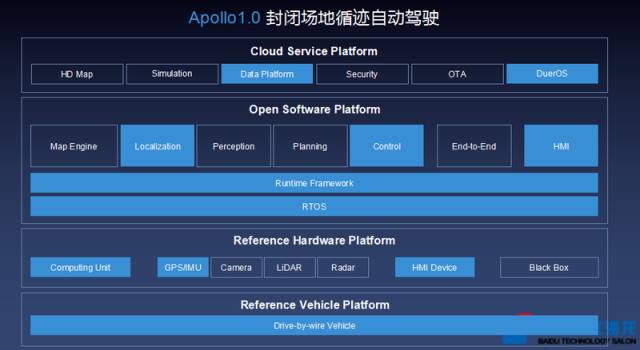
The above four layers constitute the entire technology stack of the Baidu Apollo automated driving platform. The current open Apollo1.0 features four features: efficient and easy-to-expand architecture, ready-to-use hardware, one-click startup updates, and comprehensive development tools.
Apollo's open source
Apollo 1.0 has opened three key datasets on its resources: 2D traffic lights, 3D obstacles, and Road Hackers. Baidu will open these three parts of the data to the cloud, so that users can effectively study and use. The following figure shows the architectural logic of the Apollo data open platform.
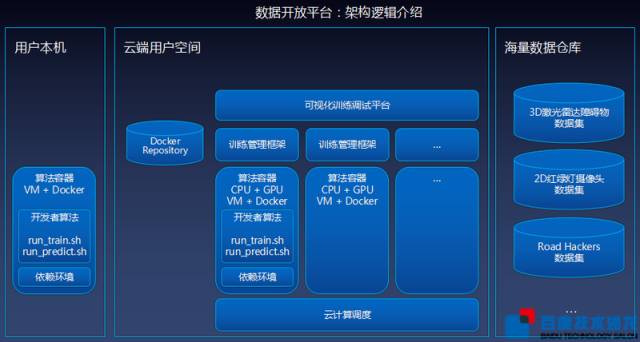
As shown in the figure, the user downloads the development environment based on the local VM + Docker through the Docker Repository in the cloud, writes training and prediction algorithms, and configures the dependent environment. Through the cloud user space visualization training and debugging platform, the user creates the algorithm container in the machine and implements scheduling in the cloud, and starts training evaluation and debugging. In this way, users can use the cluster's CPU + GPU resources to train the debug model based on massive data in the entire data open platform in the cloud, and select a valid model to use.
At the scene, Yang Fan personally demonstrated the use process and usage of the Apollo platform. This article will not repeat this article. Readers who want hands-on practice can move to the Apollo website at apollo.auto. They are available on the Developer/Data Open Platform page. Detailed introduction of use.
Apollo Code Open Framework
The autopilot system includes a series of complex functional modules such as obstacle detection, traffic light identification, driving behavior decision, and route planning. How to integrate these independent and interdependent modules into a stable operating system is a huge one. challenge. The senior architect of Baidu, He Wei, shared the exploration and practice of ROS in Baidu's automatic driving from three perspectives, from why Baidu chose ROS, how ROS improved in Apollo, and how the Apollo framework was used.
Why Baidu chooses ROS system?
On the question of why Baidu chose ROS, He explained that ROS is a powerful and flexible robot programming framework. It is also the most widely used framework in academia. It has three major features: a complete development toolkit and flexibility. The computational scheduling model and rich debugging tools can provide unified configuration management, deployment and operation, and underlying communication functions, allowing developers to focus more on the development of algorithm functions, quickly build system prototypes, and verify algorithms and functions.
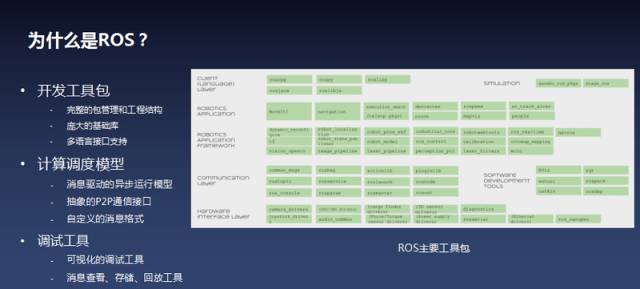
Improvements in ROS in Apollo
The advantages of the ROS system are obvious, but its use in the Apollo platform is not easy. During the process of research and development, debugging, and productization, Baidu encountered many situations. To solve these problems, Baidu made customized improvements from the aspects of communication function optimization, decentralized network topology, and data compatibility extension.
1, communication performance optimization: shared memory
Problem: In order to be able to perceive complicated road scenes and complete driving tasks, the autopilot system needs multiple sensors to work together to cover the needs of different scenarios and different road conditions. The mainstream multi-sensor fusion solution will include at least one laser radar and multiple cameras. Such a large amount of data poses a great challenge to the performance of communications.
Solution: The solution adopted by Baidu is to share memory, reduce data copies during transmission, and improve transmission efficiency.
In a one-to-one transmission scenario, the ROS nodes on the same machine are sockets for inter-process communication, and there are multiple layers of protocol stacks and multiple copies of user space and kernel space in the middle, causing a lot of unnecessary resource consumption. And loss of performance. The method of sharing memory replaces the socket as a method of communication between processes, and reduces the transmission delay and resource consumption of the system by reducing unnecessary memory copies.
In a single-to-multiple transmission scenario, when ROS is processing one-to-many message transmissions, the underlying implementation is actually a multiple point-to-point connection. When a piece of data is sent to four nodes, the same data is transmitted four times. This will cause a great waste of resources. The transfer process of the shared memory can support the functions of one-time writing and multiple reading. For a one-to-many transmission scenario, the same data packet only needs to be written once, and the transmission efficiency is improved exponentially.
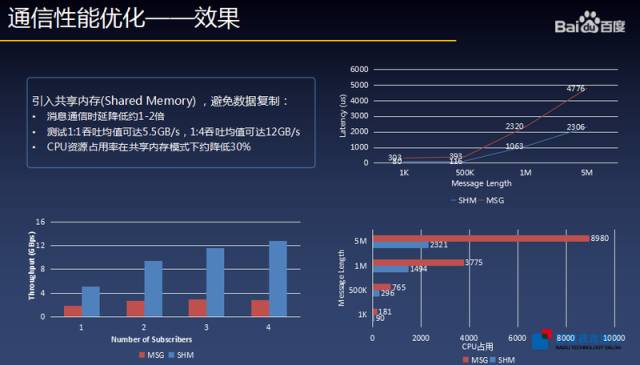
Decentralized Network Topology: Using RTPS Service Discovery Protocol
Problem: ROS is not a fully distributed framework. Each ROS network needs a central node ROS Master. When each node initializes, it will register the topology information as the Master and obtain the information of other nodes. There are two disadvantages to this approach: 1. The Master, as a single point of the system, will not be available to the entire network in the event of a crash. 2. The Master lacks an abnormal recovery mechanism and cannot automatically recover through monitoring and restart after a crash.
Solution: In order to solve this problem, Baidu added RTFS-based service discovery to the framework.
The entire network topology is no longer built around the master, but is divided by the concept of the domain. When a new node joins the network, it broadcasts broadcast information to all other nodes in the domain through the RTPS protocol. Each node also sends its own service information to the new node in place of the Master's information exchange function.
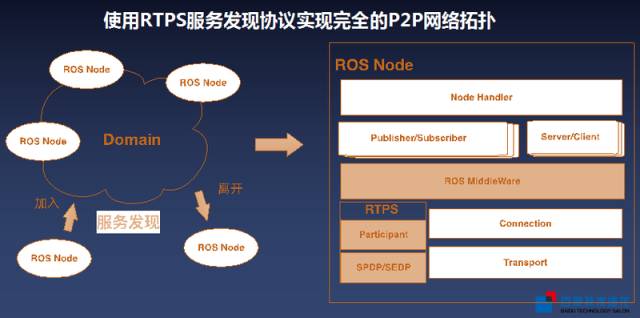
In this way, the topology discovery of the ROS network can no longer rely on the Master single point, which improves the robustness of the system. At the same time, the modification is based entirely on the ROS underlying changes and is completely transparent to the upper application. The developer does not need any code adaptation work for this function.
3, data compatibility expansion: replace Message with Protobuf
Problem: In order to ensure the consistency of the message format between the sender and the receiver, the ROS system will perform an MD5 check on the message definition. Any field addition or subtraction or order adjustment will change MD5 to ensure the robustness of the system. However, this strict restriction also causes compatibility problems. After an interface is upgraded, different modules can no longer communicate with each other, which greatly increases the coupling between module versions.
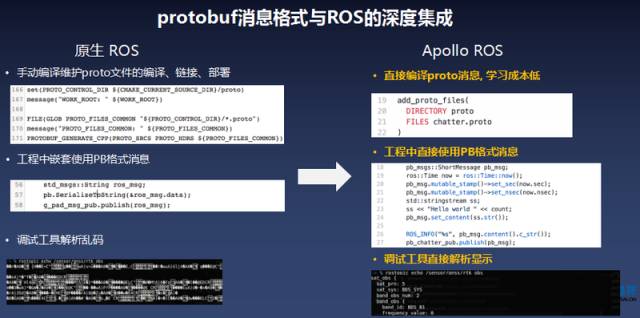
Solution: Use protobuf to replace the Message in ROS as the message definition format. Protobuf itself has good compatibility support. You only need to define the required field in use. The subsequent addition of the optional field does not affect the parsing of the message.
Introduction to Apollo Framework Usage
Later, He Yong briefly introduced the use of the Apollo framework:
The first step: install the docher system. Install and deploy the docker environment with the install-dacker script, including download, code, and a series of tasks. After the installation, you need to log out and the user re-login. This should be noted that because of changes in user rights, you need to log off the current user. Fully effective;

Step 2: Compile Apollo. Compiled code: bash Apollo.sh build;
The third step, start Apollo. The Apollo system needs to be compiled under this step and Apollo is started after the compilation is completed. Baidu provides a one-button startup version that allows full launch of background applications and front-end displays. The first step: install the docher system. Install and deploy the docker environment with the install-dacker script, including download, code, and a series of tasks. After the installation, you need to log out and the user re-login. This should be noted that because of changes in user rights, you need to log off the current user. Fully effective;

Apollo's open source code has been uploaded to the Github website at github.com/apolloauto. Interested coders can visit related tools and documentation.
End-End Autopilot Solution Based on Deep Learning
Developers want to design a complete autopilot system based on the Apollo platform. Preconditions need to understand Baidu’s autopilot system options and program details. Yu Hao, Senior Architect of Baidu’s Autopilot Division shared the traditional Rule Based and End to End for everyone. The similarities and differences between the autopilot programs and the Apollo platform's data and model practice.
Program selection based on deep learning
Yu Hao said that at present, the industry and academic mainstream is Rule based system. Rule based from the vehicle, sensor perception, World model, and then the decision-making, control, and finally to the vehicle, formed a relatively complete closed-loop system. However, there are still obvious bottlenecks in the actual application: the system is complex (artificial design), high-precision maps are expensive (requiring wide-spread and real-time updates), and computational performance (waste of resources). The End-to-End approach can solve these problems very well. The following figure shows the advantages and disadvantages of Rule based and End-to-End.
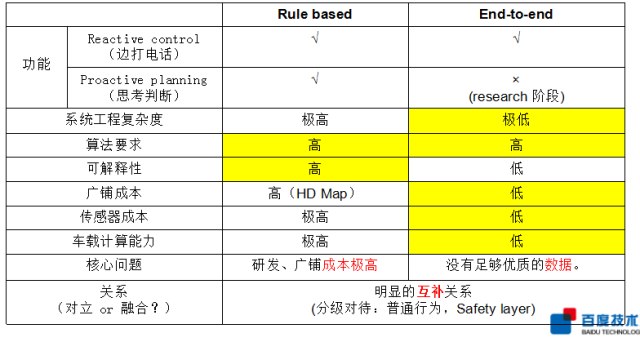
By comparison, we can see that the End-to-End solution solves some of the shortcomings of Rule based in application, but it needs further exploration and practice in basic function implementation. Yu Hao believes that both options have their own advantages and disadvantages. At this stage, it is impossible to completely rely on a certain type of deep learning program to achieve the automatic driving function. Rule based and End-to-End must be absorbed in future trends. The other side's strengths are not merged with each other.
Apollo Practice: Data
There are two types of data generation, one is real data and the other is simulator data. At present, the actual data on China's national conditions is very scarce, although the simulator data can play a role in a certain energy situation, but most of the rendering through the game, the texture of its rendering and real scene texture vary widely, almost impossible to use the real On the road.
Baidu has invested heavily in this area, and it uses a large number of data vehicles to collect millions of kilometers of data every year for analysis. Yu Hao said that the open data mainly extracted forward data, including Image, RTK-GPS, and IMU. Each open source data file corresponds to a collection task. What is more interesting here is that Baidu did not directly generate precise coordinates, but multiplied 1/R (reciprocal of the turning radius) and longitudinal instructions according to the coordinate parameters. Developers can use it to cooperate with the depot and go straight on the road.
Apollo Practice: Models
Baidu used a simple horizontal model CNN and a vertical control model Convolutional-LSTM last year. This year, Baidu merged the two together and adopted a horizontal + vertical model: LRCN. This model needs attention timing processing, Horizontal and vertical relationships, causal VS trajectory prediction, attention mechanism, and migration issues can accurately predict the surrounding environment.
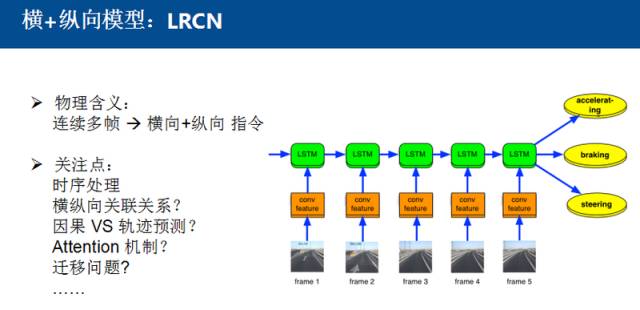
The modelling of automatic driving is still in the exploration phase. Baidu hopes to work with developers and partners to develop a truly intelligent, complete and safe automated driving solution through the opening up of resources and capabilities.
All in one pc is a new trend for desktop type computer nowadays. What you can see at this store is Custom All In One PC. There are 19 inch all in one pc, 21.5 All In One PC, All In One PC 23.8 Inch and 27 inch all in one pc, which are the main sizes at the market. How to choose the most suitable one for special application? According to clients` feedback, 19.1 inch entry level, 21.5 inch middle and low level, 23.8 or 27 inch higher level-All In One PC I7. Some clients may worry the heat-releasing since equipped releasing fan into the back of monitor, see no releasing fences on back cover. However, totally no need worry that point, cause special back cover material and releasing holes can meet the demand of heat releasing.
You can see All In One Business Computer, All In One Gaming PC, and All In One Desktop Touch Screen series at this shop.
Any other unique design or parameters, just feel free to contact us so that can get right and value information quickly.
Believe will try our best to support you!
All In One PC,All In One Pc I7,Custom All In One Pc,All In One Pc 23.8 Inch,21.5 All In One Pc
Henan Shuyi Electronics Co., Ltd. , https://www.shuyielectronics.com